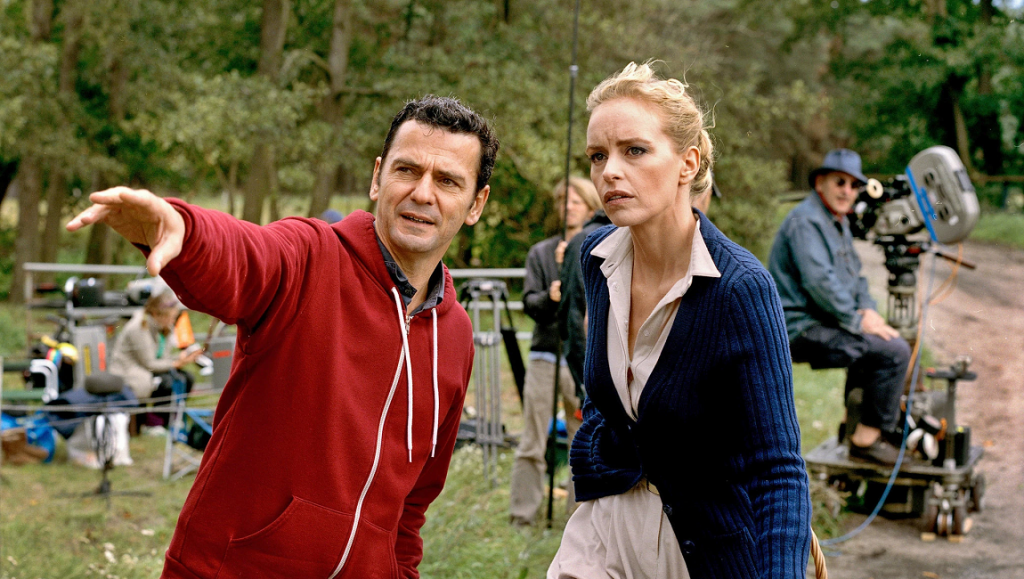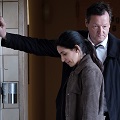“Harun [Farocki] told me that for people of his generation, the left-wing students, [Night and Fog] was the movie that showed them what had happened in the concentration camps, and so it was the movie that divided them from their parents. They understood that the German state, even the modern German state, was based on fascistic structures. When we started to talk about making Phoenix again, we knew that we wanted to make a movie that took place “in the cut”—the cut that happened between those two generations.” — Christian Petzold in conversation with Adam Nayman
This idea of existing “in the cut” is as good a metaphor as any in understanding the work of Christian Petzold, arguably contemporary cinema’s most consistent chronicler of 21st-century Europe, an era formed and defined by the economic, political, and social calamities of the preceding 20th century. Working with the great experimental documentarian Harun Farocki, who co-scripted or otherwise collaborated on every Petzold project from 1992 until his death in 2014, Petzold has fashioned an oeuvre defined by several epochal “cuts” — post-WWII reconstruction, the fall of the Berlin Wall, the reunification of East and West Berlin, late-period capitalism, the rise of neoliberalism, and the mass movement of refugees from all over the world. Hovering obliquely around all of this is Derrida’s concept of “hauntology” (derived from his book Specters of Marx), the notion that the past haunts and informs the present like a ghost. It’s equally a political and philosophical neologism, which Petzold evokes both indirectly and, occasionally, quite literally. His is a cinema of spare, liminal spaces, emptied of signifiers and becoming largely impersonal waystations — office buildings, corporate parks, banks, airports, industrial warehouses, anonymous restaurants and cafeterias, and, of course, the interiors of trains and cars, each a method of conveyance with symbolically loaded histories. Another specter haunts Petzold, that of classical cinema, Alfred Hitchcock in particular. Echoes of Vertigo reverberate throughout many of his films, like ripples across water, a modern touchstone that informs individual works in mysterious ways. Petzold also nods to (whether implicitly or explicitly) The 39 Steps (Pilots), Detour (Cuba Libre), Eyes Without a Face (Phoenix), The Postman Always Rings Twice (Jerichow), Casablanca (Transit), and Carnival of Souls (Yella), amongst others (most curiously, Petzold has revealed in interviews that The State I Am In is indebted to Kathryn Bigelow’s neo-western vampire opus Near Dark). Indeed, Petzold himself occupies a kind of “cut,” one situated between genre films and art films. That he frequently makes the former under the guise of the latter is a large part of his appeal, collapsing boundaries between modes and moving about freely in both worlds.

Born to East German political refugee parents in 1960, Petzold was raised in Haan, located in the western part of West Germany near the Ruhr region. Long considered Germany’s industrial core, the area underwent various waves of destruction and reconstruction during and after WWII. As Jaimey Fisher details in his book on Petzold, Christian Petzold, part of the University of Illinois’ “Contemporary Film Directors” series, this upbringing, surrounded by a post-industrial landscape and mostly working-class peoples, seems to have left a profound mark on Petzold, informing his fascination with “transit spaces,” Eventually, moving to Berlin after completing his mandatory civil service, Petzold would enroll at the Freie Universitat (Free University), earning a master’s degree in German literature. Petzold was then admitted to the DFFB (German Film and Television Academy of Berlin) in 1989. It was here that he met and studied under Hartmut Bitomsky, Helke Sander, and most importantly, Harun Farocki. It was also during this time that the Berlin Wall fell — an epochal, world-altering event that fundamentally changed both European and international politics.
Petzold spent much of the ’90s working in television production (a mode he would return to frequently), until his breakthrough film The State I Am In was released in Germany in 2000, with an international rollout following in 2001. A watershed moment in the formation of “The Berlin School,” Petzold became the most prominent of this loose confederation of directors. In a 2008 article for Cineaste magazine, Marco Abel gives a useful primer on the moniker, including important social and historical context. To summarize briefly, the term was originally coined by French critics after the popular success of The State I Am In to differentiate it and films by Angela Schanelec and Thomas Arslan (schoolmates of Petzold’s at the DFFB) from the current trends of mainstream, commercial German filmmaking, which the trio were actively reacting against. It’s now also frequently applied to a so-called “2nd generation” of contemporary filmmakers, including Christopher Hochhausler, Ulrich Kohler, and Valeska Griesbach, as well as tangential figures like Maren Ade. Many of these directors are affiliated with the film journal Revolver, though not all, and most of the so-called “members” reject any kind of purposeful or coordinated movement (they’ve never issued a manifesto, for instance). Still, as Fisher writes, “even if the Berlin School has not formally defined itself as a school or wave, filmmaking in this mode has become one of the most important aesthetic/artistic developments in post-cold war European Cinema…”

While perhaps fruitless to declare who might be the “best” amongst such a varied coterie of directors, it is undeniable that Petzold has had the most success outside of the rarified world of film festivals. The last 20 years have been a remarkably fruitful period for Petzold, as he has consistently tilled the same sets of formal and conceptual concerns. His lush partnership with Farocki is most certainly an important part of this consistency, as is Petzold’s relationship with his favorite leading lady, Nina Hoss, who has appeared in nearly every Petzold film from 2001’s Something to Remind Me up until 2014’s Phoenix (after which the pair agreed to a mutual, reportedly temporary, parting of ways). A beautiful woman with a severe countenance, her rigid, sometimes regal posture belies a deep-rooted sensitivity. Frequently tasked with playing inscrutable women bearing some kind of secret, she’s a classic femme fatale reconfigured into the center of gravity around which Petzold’s films orbit. We’ll be exploring this relationship as we dive into each of Petzold’s theatrical films, as well as several of his made-for-television features (his episodic work remains difficult, if not impossible to come by in the U.S.). It’s a fascinating body of work, with cold, sparse surfaces that contain a surfeit of explosive emotions — indeed, Petzold might be our last true purveyor of the melodrama. Ultimately, his main concern is nothing less than the fate of humanity in the face of monumental historicized upheavals, as the burden of modernity weighs us all down.
Over the course of the next week, InRO writers will take on the entire Christian Petzold feature catalog, as well as a smattering of his television films and episodic work. Three new pieces will be published Monday–Thursday, followed by Undine on Friday, its official release day — to the tune of 13 total pieces.
Cuba Libre (1996), The State I Am In (2000), Something to Remind Me (2002), Wolfsburg (2003)
Gespenster (2005), Yella (2007), Jerichow (2008), Dreileben — Beats Being Dead (2011), Barbara (2012)
Phoenix (2014), Tatorte (2018), Transit (2018), Undine (2020).















Comments are closed.